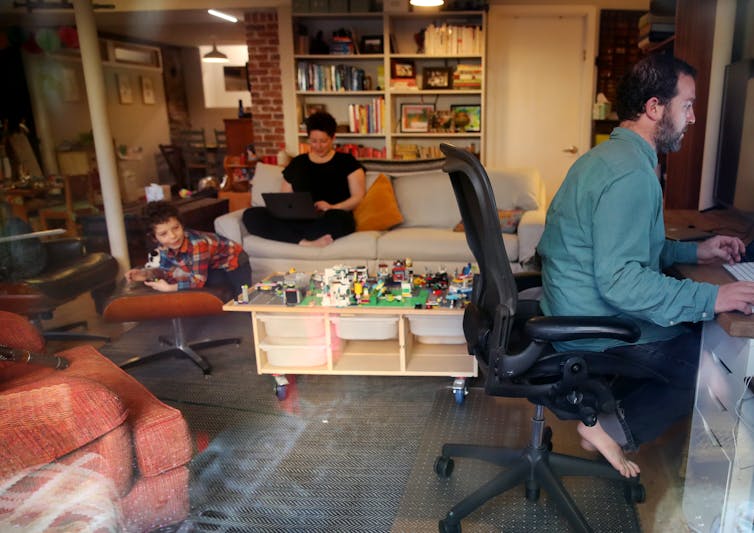Kids' school schedules have never matched parents' work obligations and the pandemic is making thing
For US parents, the health, economic and social crisis the COVID-19 pandemic brought about is compounded by the difficult if not impossible task of working, caring for and educating kids.

Whether I’m looking at the question of why it has always been hard to be a working parent in the United States as a mother with two children under 7, or as a scholar of child and family policy, one reason stands out. The hours employers demand and public school schedules have always been incompatible.
While children attend K-12 public schools for an average of 1,195 hours per year, a full-time working parent averages twice as much time, about 2,450 hours per year, working and commuting.
This fall, it looks like millions of U.S. children will spend no hours at school at all. And for nearly every parent, the usual complicated dance between their jobs and their kids’ daily schedules has become even more complex, as school systems adjust their plans in accordance with what’s possible during the COVID-19 pandemic.
As of mid-July, for example, New York City – the country’s biggest school district – was planning to have children in classrooms only two or three days a week once the new school year gets underway. Los Angeles – the second-largest – was planning to keep learning fully online.
An issue of inequality
Finding affordable and reliable child care is especially hard for parents with infants and toddlers, those whose children have special needs, or those working nights, weekends or unpredictable schedules.
Public pre-K programs and the federally funded Head Start program together enroll only 47% of 4-year-olds and 17% of 3-year-olds and most of these programs are only “half-day,” meaning that they run for four hours at most.
Once children are ready for elementary school, only a handful of states require full-day kindergarten.
Wealthy and high-earning parents bridge this gulf for their children of all ages with elaborate – and expensive – webs of paid people and programs that can include in-school after-care, enrichment activities, babysitters and nannies.
Parents who can’t afford those things and have few choices rely instead on their relatives, neighbors and friends to fill the gaps schools don’t cover with more informal arrangements.
Now even worse
Since March 2020, most U.S. parents have faced the daunting task of working full-time while caring for – and at least attempting on school days to help teach – their children all week long.
This challenge is widespread. An estimated one-third of U.S. workers have child care obligations.
With schools and child care programs largely shuttered, most summer camps canceled or online, and families understandably reluctant to rely on elderly relatives, the hours of child care have gone, in many cases, to zero. But for the workers lucky enough to remain employed, work hours have held steady.
Moreover, social distancing guidelines discourage associating with others outside of the household – which can include nannies and babysitters.

Moving on
I anticipate that many parents, mostly mothers, will be forced to miss work, cut their hours or quit their jobs. Taking this step might make help make life less hectic and ensure care for their children in the short term. But it also takes a toll on their current and future economic security.
I don’t think juggling work and parenting has to be this hard, or that things should ever have been as hard as they were before this crisis. After the pandemic ends, the U.S. shouldn’t aspire for parents to return to the expensive, exhausting jujitsu of 2019.
I argue that the nation should, in the long term, ensure that everyone has access to affordable, high-quality options that span from infancy through the teen years through a combination of child care subsidies and more funding for care for children before and after the school day.
More spending on infant and toddler care and summer activities – a time of year during which families often struggle to find and pay for care – could help reduce income gaps in children’s readiness for kindergarten and summer learning loss.
The COVID-19 pandemic has exposed parents’ delicate, very difficult and unsustainable balancing act.
This complex crisis offers a time of reckoning. Americans have an opportunity to re-imagine how the government can support family life – to make raising children less expensive, less stressful, more socially just and simply better for everyone.
Taryn Morrissey has received funding from the Robert Wood Johnson Foundation, the US2050 Project of the Ford and Peterson Foundations, the Bill and Melinda Gates Foundation, the Heising-Simons Foundation, the Annie E. Casey Foundation, the Pritzker Children's Initiative, the Bainum Family Foundation, and the Perigee Fund, and the U.S. Departments of Health and Human Services and Agriculture. She is a non-resident fellow at the Urban Institute and in 2020 a Senior Fellow at the Center for American Progress.
Read These Next
West Coast levee failures show growing risks from America’s aging flood defenses
Levees protect more than 7 million buildings in the US today, yet they got a D-plus grade in 2025. A…
LA fires showed how much neighborliness matters for wildfire safety – schools can do much more to te
Managing fire risk is about more than regulations and rules. It’s also about caring for neighbors…
Has the Fed fixed the economy yet? And other burning economic questions for 2026
As 2026 begins, uncertainty is at the top of everyone’s mind.






